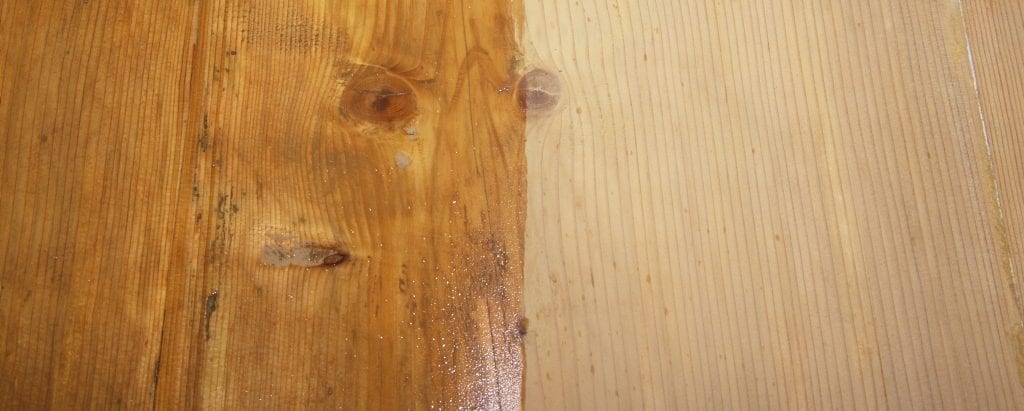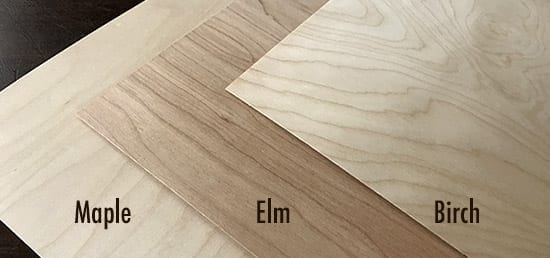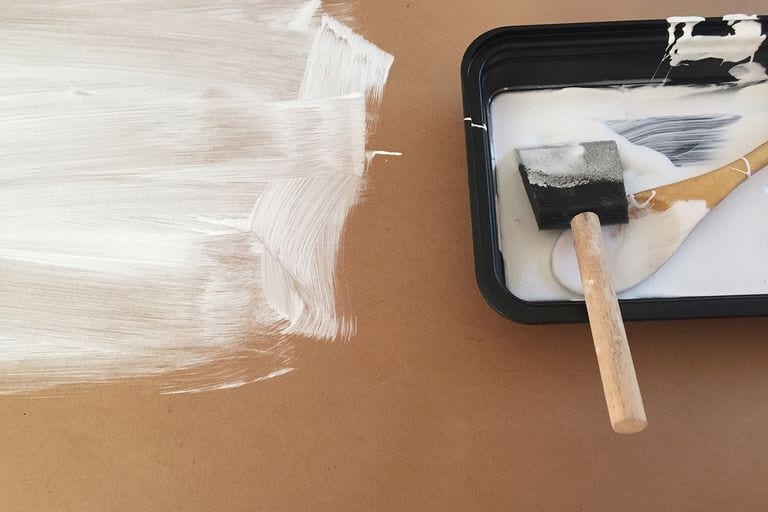How To Prime A Canvas For Oil Painting Without Gesso
Oil painting is one of the near inexpensive means to paint, and allows you lot to apply your art to a myriad of surfaces, including forest.
Yeah, y'all can practise oil painting on wood, just there'southward more to it than just slapping a brush against a 2×4.
You lot demand something dry that won't warp over time, which is unremarkably why a cotton canvas is preferred.
Even then, the cotton canvas is stretched over thin bits of wood in an internal frame, and it's done for a couple of reasons.
For one, it's extremely like shooting fish in a barrel to aerate.
You have to give your painting plenty of oxygen while painting it so that it dries out instead of rotting the fabric it's being applied to.
This is obviously a big problem if you're planning to paint on woods, but there's a manner to do information technology properly.
You have to prime the wood prior to painting on it.
In that location'south a few means that this can exist washed, and information technology doesn't take much time at all, but it absolutely must be washed before any pigment touches the woods.
Contents
- 1 How to Prime Woods for Oil Painting?
- ane.one Turpentine/Tung Oil
- 1.2 Linseed Oil
- 1.iii Gesso
- ii How Long Does Gesso Take to Dry out?
- 3 What is the Best Wood for Oil Paints?
- 4 Do I Need to Seal the Unabridged Piece of Wood?
- 5 How to Seal Wood?
- half dozen Fine art Applies to Everything
How to Prime number Forest for Oil Painting?
You need a mixture to treat the forest with start.
This creates a thin barrier between the paint and the wood, which will forestall harm and the wear and tear of time.
The goal is to dry the wood out.
Rot occurs when wet is trapped and turns into mold, mildew, or when mold and mildew dry out out and turn into dry rot.
Dry it out and create a seal, and this isn't going to happen.
You tin can use iii different things to prime the wood and dry out it out.
Turpentine/Tung Oil
Turpentine dries wood out, but it besides seals it.
Turpentine comes from a mixture of unlike tree gum and sap, which when mixed creates a stiff-smelling resin that'southward often added to wood varnish, paints, and pigment thinner.
Turpentine is commonly used to thin out acrylic paints, and works well to treat wood that'south going to be put through harsh weather.
Turpentine should be mixed with a tung oil in a l/fifty blend in lodge to help treat and prime number wood for painting.
Tung oil is found in varnishes equally well equally paints. Throwing straight turpentine into your oil paint could crusade it to carve up, so a l/l mix will do the fob.
Linseed Oil

Linseed oil has been used for hundreds of years, and is the chief alternative to using turpentine.
Since turpentine is very toxic, y'all might not want to utilize information technology if you have piddling ones in the firm that could go their hands on the wooden surface.
Information technology'due south also better for you to not be inhaling the turpentine or tung oil fumes.
You may also know linseed oil by something else: flaxseed oil.
Information technology's a yellowish liquid that's taken from dried flax plants, and isn't chemic-based, so information technology'due south safe to use on your wooden surfaces. This doesn't have long to dry out, and acts as a shield between your wood and the oil paint.
Gesso
If you don't fancy mixing turpentine and tung oil, your adjacent best option is gesso.
You don't hear much nigh it, because it's no longer required for commercial construction. Joint chemical compound and sheetrock are made with their own surface that holds onto paint extremely well.
Notwithstanding, it's yet used in smaller projects where you lot're refinishing or repurposing something. Gesso was originally used to treat canvases and then that the paint would stick to it.
Way back when they made canvases out of rough cotton, it was the only mode to go paint to blend with the cloth.
As far as wood goes, it's used when yous repaint your deck and accept to care for the wood beforehand.
Gesso also has multiple textures that you can get, including smoothen, textured, and rough (which normally comes from a spray tin).
At that place are ii grades of gesso that y'all tin purchase.
Even though they might exist fabricated for canvases, you can apply them to wood.
Pupil grade gesso is, as you lot might imagine, slightly less viscous and powerful. It'south also cheaper and comes in more abundance.
Creative person class gesso is basically a super concentrated version of educatee grade gesso.
Less volume, more expensive, but you require less to dry out a canvas or woods.
Depending on the size of your woods surface (such every bit if you're painting on an interior wooden wall), you lot might exist better off ownership a commercial course gesso in a high book for budgeting purposes.
This will allow y'all to cover the entire wall without going bankrupt (after all, you yet have to get the paint).
How Long Does Gesso Take to Dry?
Gesso is a drying agent, so information technology doesn't take that long.
Yous can usually walk away from your project and render no less than twenty minutes subsequently, and have a completely dry surface to paint on.
If yous like to err on the side of caution equally many of us practise, leave it for an hr to be 100% sure that it's dried properly.
What is the Best Wood for Oil Paints?

There are two main types of forest that are readily bachelor, and absolutely perfect for applying oil paint to.
Commencement is birch woods, which is often used past canvas makers.
Birch is fairly pouros, which is why nosotros don't want to immediately add the oil pigment to it. Use two layers of gesso to ensure the liquid in oil paint doesn't seep in and rot the wood.
Next is maple, which is a nice, rigid and hard wood.
It's often used in decorative augmentations in furniture and aesthetic elements of your home, simply if you can order a full panel of maple forest, it's going to be the best thing you've e'er oil painted on.
You lot can buy either of them from multiple online sources.
They will come completely untreated, so once more, take plenty of gesso, linseed oil, or your turpentine/tung oil blend at-the-ready.
You can besides use other types of wood if these are as well pricey.
Plywood or hardboard are both excellent, though they might require an additional coat of your preferred dying agent.
You tin usually get pieces that are at least ¾" thick without spending a lot of coin.
Plywood needs to be dried and sealed more than any other type of wood. Information technology's compressed during production, but there are still plenty of crevices for moisture to slip into.
If neither of those options are available to you or don't seem similar the all-time choice, then you can go for a laminated compressed cardboard with a mica pic on it.
It requires less treating, only is slightly more catatonic to bargain with.
Research the individual forest that you're planning on using.
Some woods tin leach chemicals from the treatment process into the paint and yellowish information technology, others can exist extremely resistant to gesso (then yous might need acrylic gesso instead).
Basically, you need to have a expect at each private woods type and notice out the pros and cons of information technology prior to buying information technology.
Practice I Need to Seal the Entire Piece of Wood?

Yes, you lot should seal the entire piece of woods, regardless of what sealant or drying agent you're using.
Even when it's cut, prepared, and partially treated, raw pieces of wood nevertheless have a decent amount of moisture locked within of them.
Apart from that, at that place are plenty of natural fibers that will absorb water the second that it touches it.
If you're ownership a panel of forest that's going to be positioned somewhere then painted, you accept to seal the entire thing, fifty-fifty the backside.
It can go a little more complicated if you're going to paint onto a pre-existing piece of wood in your abode, such as an inside retaining wall or the front of a counter area.
How to Seal Wood?
Utilise a putty pocketknife with a broad edge so you lot can apply the sealant of your selection.
The biggest difficulty you're going to encounter with sealing or treating your forest board is getting the layers overnice and even.
This is why you'll need to apply multiple coats.
Apply the first coat with a putty knife.
Get it as even as possible. It's plausible to assume that you tin can't get a 100% perfectly even coat the first time, so employ a sandpaper block with at least 600 grit to polish it out.
Apply the second coat and repeat the process until smooth and sealed properly.
Art Applies to Everything
No affair what, there's a way to use art to literally everything in your life.
Whether information technology has to be treated, sanded, primed or built from scratch, y'all can use oil painting to transform just most anything in your home.
You're the artist; the fine art is simply a mark of your creativity that'south left backside, so apply it to everything you can get your brush on.
Source: https://thepaintingadvice.com/can-you-use-oil-paint-on-wood/
Posted by: munntrown1991.blogspot.com


0 Response to "How To Prime A Canvas For Oil Painting Without Gesso"
Post a Comment